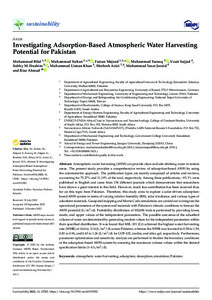| dc.date.accessioned | 2022-11-08T15:46:33Z | |
| dc.date.available | 2022-11-08T15:46:33Z | |
| dc.date.issued | 2022-10-03 | |
| dc.identifier | doi:10.17170/kobra-202211087080 | |
| dc.identifier.uri | http://hdl.handle.net/123456789/14238 | |
| dc.description.sponsorship | Gefördert durch den Publikationsfonds der Universität Kassel | |
| dc.language.iso | eng | |
| dc.rights | Namensnennung 4.0 International | * |
| dc.rights.uri | http://creativecommons.org/licenses/by/4.0/ | * |
| dc.subject | atmospheric water harvesting | eng |
| dc.subject | adsorption | eng |
| dc.subject | desorption | eng |
| dc.subject | Pakistan | eng |
| dc.subject | simulation | eng |
| dc.subject.ddc | 570 | |
| dc.subject.ddc | 630 | |
| dc.title | Investigating Adsorption-Based Atmospheric Water Harvesting Potential for Pakistan | eng |
| dc.type | Aufsatz | |
| dcterms.abstract | Atmospheric water harvesting (AWH) can provide clean and safe drinking water in remote areas. The present study provides a comprehensive review of adsorption-based AWH by using the scientometric approach. The publication types are mainly composed of articles and reviews, accounting for 75.37% and 11.19% of the total, respectively. Among these publications, ~95.1% were published in English and came from 154 different journals which demonstrates that researchers have shown a great interest in this field. However, much less contribution has been received thus far on this topic from Pakistan. Therefore, this study aims to explore a solar-driven adsorption-based AWH system in terms of varying relative humidity (RH), solar irradiance, and various types of adsorbent materials. Geospatial mapping and Monte Carlo simulations are carried out to integrate the operational parameters of the system and materials with Pakistan’s climatic conditions to forecast the AWH potential (L/m²/d). Probability distribution of 100,000 trials is performed by providing lower, mode, and upper values of the independent parameters. The possible outcomes of the adsorbed volume of water are determined by generating random values for the independent parameters within their specified distribution. It was found that MIL-101 (Cr) achieved the highest water-harvesting rate (WHR) of 0.64 to 3.14 (L/m²/d) across Pakistan, whereas the WHR was lowered to 0.58 to 1.59, 0.83 to 0.94, and 0.45 to 1.26 (L/m²/d) for COF-432, zeolite, and silica gel, respectively. Furthermore, parameter optimization and sensitivity analysis are performed to finalize the boundary conditions of the adsorption-based AWH system by ensuring the maximum volume values within the desired specification limits (1–4 L/m²/d). | eng |
| dcterms.accessRights | open access | |
| dcterms.creator | Bilal, Muhammad | |
| dcterms.creator | Sultan, Muhammad | |
| dcterms.creator | Majeed, Faizan | |
| dcterms.creator | Farooq, Muhammad | |
| dcterms.creator | Sajjad, Uzair | |
| dcterms.creator | Ibrahim, Sobhy M. | |
| dcterms.creator | Khan, Muhammad Usman | |
| dcterms.creator | Azizi, Shohreh | |
| dcterms.creator | Javaid, Muhammad Yasar | |
| dcterms.creator | Ahmad, Riaz | |
| dc.relation.doi | doi:10.3390/su141912582 | |
| dc.subject.swd | Pakistan | ger |
| dc.subject.swd | Wassergewinnung | ger |
| dc.subject.swd | Simulation | ger |
| dc.subject.swd | Adsorption | ger |
| dc.subject.swd | Desorption | ger |
| dc.subject.swd | Trinkwasser | ger |
| dc.subject.swd | Wassergewinnung | ger |
| dc.subject.swd | Luftfeuchtigkeit | ger |
| dc.type.version | publishedVersion | |
| dcterms.source.identifier | eissn:2071-1050 | |
| dcterms.source.issue | Issue 19 | |
| dcterms.source.journal | Sustainability | eng |
| dcterms.source.volume | Volume 14 | |
| kup.iskup | false | |
| dcterms.source.articlenumber | 12582 | |


